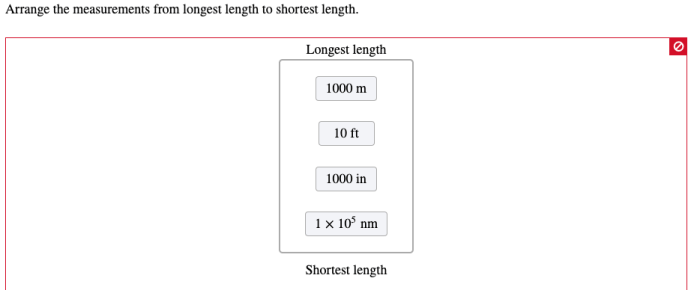Arrange the measurements from longest length to shortest length. Understanding measurement length and organizing measurements by length are crucial aspects of various fields, including engineering, construction, and science. This comprehensive guide delves into the concept of measurement length, different units of measurement, and methods for arranging measurements from longest to shortest length, providing valuable insights and practical applications.
By understanding the principles of measurement length and employing effective organizing techniques, individuals can ensure accuracy and consistency in their measurements, leading to reliable and meaningful results.
Understanding Measurement Length: Arrange The Measurements From Longest Length To Shortest Length.
Measurement length is the process of determining the extent of an object or distance. It involves comparing the object or distance to a standard unit of length, such as a meter, inch, or foot. The result of a measurement is expressed as a number followed by the unit of length used.
There are many different units of measurement for length, each with its own advantages and disadvantages. The most common unit of length in the world is the meter, which is defined as the distance traveled by light in a vacuum in 1/299,792,458 of a second.
Other common units of length include the inch, the foot, the yard, and the mile.
It is important to use consistent units of measurement when measuring length. This ensures that the measurements are accurate and can be compared to each other. For example, if you are measuring the length of a room, you should use the same unit of measurement throughout the measurement.
You should not use meters for one wall and inches for another.
Organizing Measurements by Length
Measurements can be organized by length in a variety of ways. One common method is to use a table. A table can be used to organize measurements from longest length to shortest length or vice versa.
| Measurement | Length |
|---|---|
| 1 mile | 1.609 kilometers |
| 1 kilometer | 0.621 miles |
| 1 foot | 0.305 meters |
| 1 inch | 2.54 centimeters |
Examples of Measurements

Measurements can be used to describe the length of a variety of objects and distances. Some common examples of measurements include:
- The height of a building
- The distance between two cities
- The length of a piece of paper
- The volume of a liquid
Methods for Arranging Measurements
There are a variety of methods for arranging measurements from longest length to shortest length. One common method is to use a sorting algorithm. A sorting algorithm is a computer program that can be used to arrange a list of items in a specific order.
There are many different sorting algorithms available, each with its own advantages and disadvantages.
Another method for arranging measurements from longest length to shortest length is to use a ruler. A ruler is a measuring device that can be used to measure the length of an object. Rulers are typically marked with a series of evenly spaced lines, each of which represents a specific unit of length.
To use a ruler to arrange measurements from longest length to shortest length, simply place the ruler next to the objects and read the measurements.
Procedures for Verifying Accuracy

It is important to verify the accuracy of measurements before using them. There are a variety of procedures that can be used to verify the accuracy of measurements. One common procedure is to use a calibration standard. A calibration standard is a known measurement that can be used to check the accuracy of a measuring device.
Another procedure for verifying the accuracy of measurements is to use a second measuring device. By comparing the measurements from two different measuring devices, you can check for consistency. If the measurements are consistent, then you can be more confident in the accuracy of the measurements.
Applications of Organized Measurements

Organized measurements can be used in a variety of applications. Some common applications include:
- Engineering
- Construction
- Science
In engineering, organized measurements are used to design and build structures. In construction, organized measurements are used to ensure that buildings are built to the correct specifications. In science, organized measurements are used to collect data and conduct experiments.
Common Queries
What is the importance of using consistent units of measurement?
Using consistent units of measurement is essential to ensure accuracy and comparability of measurements. Different units of measurement represent different magnitudes, and mixing them can lead to confusion and errors. By standardizing the units of measurement, individuals can ensure that their measurements are consistent and can be easily compared and analyzed.
What are some examples of different units of measurement for length?
Common units of measurement for length include meters, centimeters, kilometers, inches, feet, and miles. The choice of unit depends on the context and the desired level of precision.
What are some methods for arranging measurements from longest to shortest length?
Measurements can be arranged from longest to shortest length using various methods, such as sorting algorithms, manual comparison, or using a spreadsheet with built-in sorting functionality. The choice of method depends on the number of measurements and the desired level of accuracy.